page 9
~ The Study of Threes ~
http://threesology.org
| Hybrids page 1 | Hybrids page 2 | Hybrids page 3 | Hybrids page 4 | Hybrids page 5 |
| Hybrids page 6 | Hybrids page 7 | Hybrids page 8 | Hybrids page 9 | Hybrids page 10 |
| Hybrids page 11 | Hybrids page 12 Playmate God |
Hybrids 13 Economics 1 |
Hybrids 14 Economics 2 |
Hybrids 15 Economics 3 |
| Hybrids 16 Economics 4 |
Hybrids 17 Economics 5 |
Hybrids 18 Economics 6 |
Hybrids 19 Economics 7 |
Hybrids 20 Language 1 |
| Hybrids 21 Language 2 |
Hybrids 22 Language 3 |
Hybrids 23 Language 4 |
Hybrids 24 Physics |
Hybrids 25 |
| Hybrids 26 | Hybrid 27 |
Visitors as of 30th July, 2021

The previous two pages were written on impulse drive, so let me get back to the previous illustration from the Hybrids page 7, displaying the Earth associated with several different kinds of cosmological movement, and rekindled here so you don't have to go back to the page and interrupt you flow of thought:
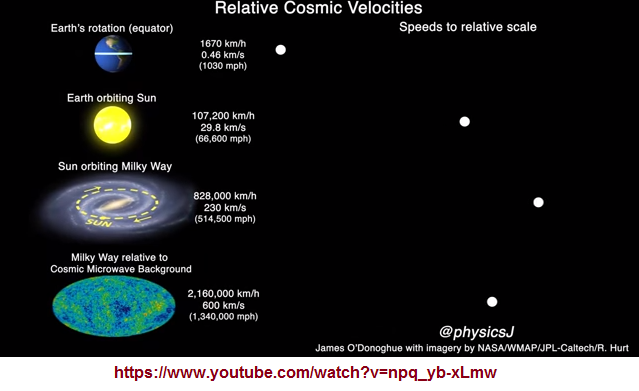
Surely there are some basic influences (on animated and inanimate objects) which take place according to planetary phenomena... such as for example, the rotation of the planet. It is an activity which some, many, most or all life forms may come to represent... if not in their biological/physiological development, then in thoughts, feelings or actions. I am not talking about the well-documented circadian rhythms nor the ideas associated with Astrology. In an alternative case of supposition, we do in fact find multiple references to roundness, circularity, and rotation... or that which describes such if not in actual words but deeds; such as in the case where we may or may not be able to recognize ideas such as a spinning thought [or feeling process(es)] though we have multiple ideas which one might interpret to be reflective thereof:
- A well rounded education
- A circular conversation
- A circle of friends, neighbors, colleagues, etc...
- Surrounded by friends, family and relatives.
- A tightly knit group (we assume as a roundish enclave)
- Various words used for a human/animal/insect, botanical, etc., group, gathering, association which imply a circular-like closure.
- Wanting people around us
- Doing things in a round-a-bout way.
- Circular shell configurations representing electron energy levels.
- seeking venues where others revolve around us or we around them
- Emergency personnel surrounding a location (fire, police, rescue...)
- etc...
If one visualizes a group or gathering or bunch, etc. in terms of a geometric model, what design comes to mind? A square, triangle, rectangle, diamond shaped or circle? If one focuses on a group of friends or colleagues, etc., and thinks of them in a hierarchical fashion, what shape does the hierarchy take? Is it triangular, a ladder, a slope, a bar graph or some curvature assigning higher to lower?
We have round planets, round eyes and round skulls; as well as the sometimes proposed circular shape for atomic particles and molecules, though in describing a shape by the range of electron orbitals, far too often we focus on the proposition of a particle being expressed with a given shape, instead of looking at the shapes of orbitals as a deformation of the space as a distortion. If we include the idea of a wave's involvement in the shape, one might be inclined to think of a wave as being as jagged as waves are typically illustrated... like a series of sharp (high) pointed mountains interconnected with sharp (deep) valleys. The problem of relying on presumed trajectories in accounting for an underlying form or formula, is that the image may be distorted. Take for example the trajectories of a ball connected to a rubber band attached to an objects such as a wooden paddle. What do the multiple trajectories of the ball (as a particle) and rubber band (as a wave), tell you about the trajectory of the paddle, if its trajectories even come to mind as part of the equation? How well could a person illustrate a baseball bat by the different trajectories of the ball being hit by it?
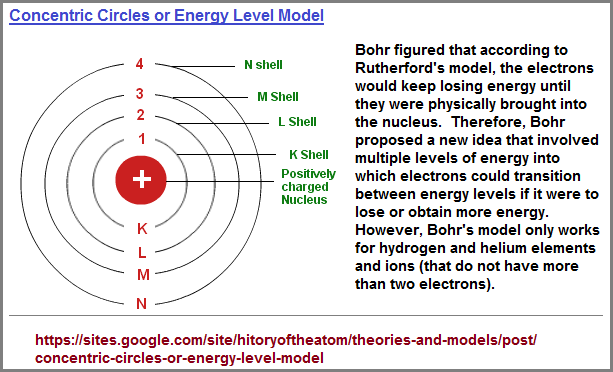
If we think that the trajectories of a foraging animal with a nest, burrow or cave den can help us to locate an origin, does it not also describe a particular environmental setting? Do the trajectories of sand particles being flung about as a means to entrap an insect further into its burrow, does it not also describe the deformations of the burrow in the medium of the ground? Likewise for the contour of the space within which an electron is thought to inhabit. The ball and the rubber band as a wave and particle expression of an electron, have a capacity for gaining and losing energy from the paddle, which can be viewed as the atomic field which permits the particle/wave ensemble to gain or lose energy within the constraints of the field. If the field strength is small so shall the quantity of energy states. The electron can give out or absorb energy from photons, but it can only be reduced in energy to the ground state... or floor of a given atom in question. A sub-floor (or basement) is thus a reference to an anti-particle situation.
Let us expand upon this analogy of using a building with an elevator as a model for the atom in order to describe not only energy levels but the ground level energy state as well as the idea of "anti-particles, waves, energies" as being represented by a basement or sub-floors which can be extended downward as needed for which ever conversational reference we are making. Let us first look at a bit of history:
Shell nuclear model, description of nuclei of atoms by analogy with the Bohr atomic model of electron energy levels. It was developed independently in the late 1940s by the American physicist Maria Goeppert Mayer and the German physicist J. Hans D. Jensen, who shared the Nobel Prize for Physics in 1963 for their work. In the shell nuclear model, the constituent nuclear particles are paired neutron with neutron and proton with proton in nuclear-energy levels that are filled, or closed, when the number of protons or neutrons equals 2, 8, 20, 28, 50, 82, or 126, the so-called magic numbers that indicate especially stable nuclei. The unpaired neutrons and protons account for the properties of a particular species of nucleus as valence electrons account for the chemical properties of the various elements. The shell model accurately predicts certain properties of normal nuclei, such as their angular momentum; but for nuclei in highly unstable states, the shell model is no longer adequate and must be modified or replaced by another model, such as the liquid-drop model, collective model, compound-nucleus model, or optical model. (Britannica: Shell Nuclear Model)
Magic number, in physics, in the shell models of both atomic and nuclear structure, any of a series of numbers that connote stable structure.
The magic numbers for atoms are 2, 10, 18, 36, 54, and 86, corresponding to the total number of electrons in filled electron shells. (Electrons within a shell have very similar energies and are at similar distances from the nucleus.) In the chemical elements of atomic number 17 to 19, for example, the chloride ion (Cl-), the argon atom (Ar), and the potassium ion (K+) have 18 electrons in closed-shell configurations and are chemically quite stable. The number of electrons present in the neutral atoms constituting the relatively unreactive noble gases exactly correspond to the atomic magic numbers.
The magic numbers for nuclei are 2, 8, 20, 28, 50, 82, and 126. Thus, tin (atomic number 50), with 50 protons in its nucleus, has 10 stable isotopes, whereas indium (atomic number 49) and antimony (atomic number 51) have only 2 stable isotopes apiece. The doubly magic alpha particle, or helium-4 nucleus, composed of two protons and two neutrons, is very stable. In nuclei, this increased stability occurs when there is a large energy gap between a series of filled energy levels and the next level, which is empty. Such large gaps are said to separate shells, although these shells are not as clearly linked to the spatial structure of the nucleus as electron shells are to their orbits. (Magic Number (atomic structure))
The number of protons and neutrons is called the Mass number. Electrons, with negligible mass in contrast, are not considered as part of the Mass number calculation.

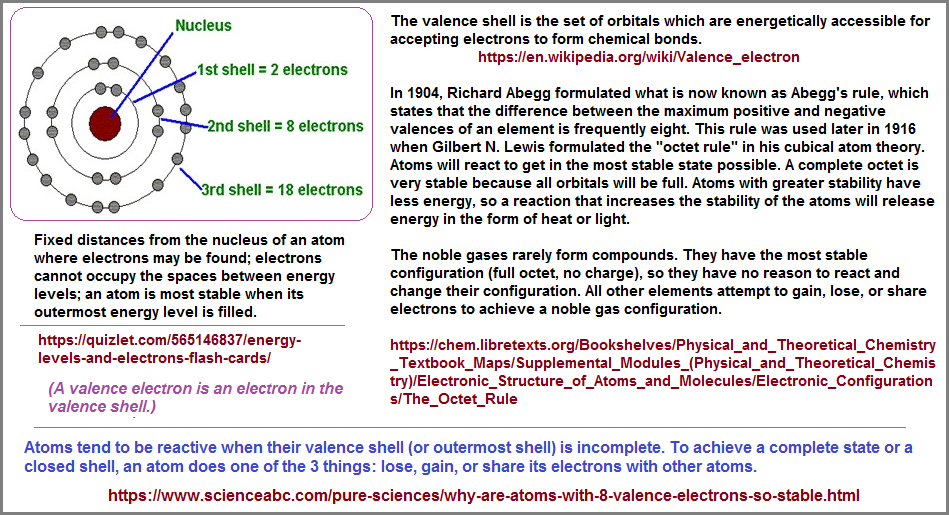
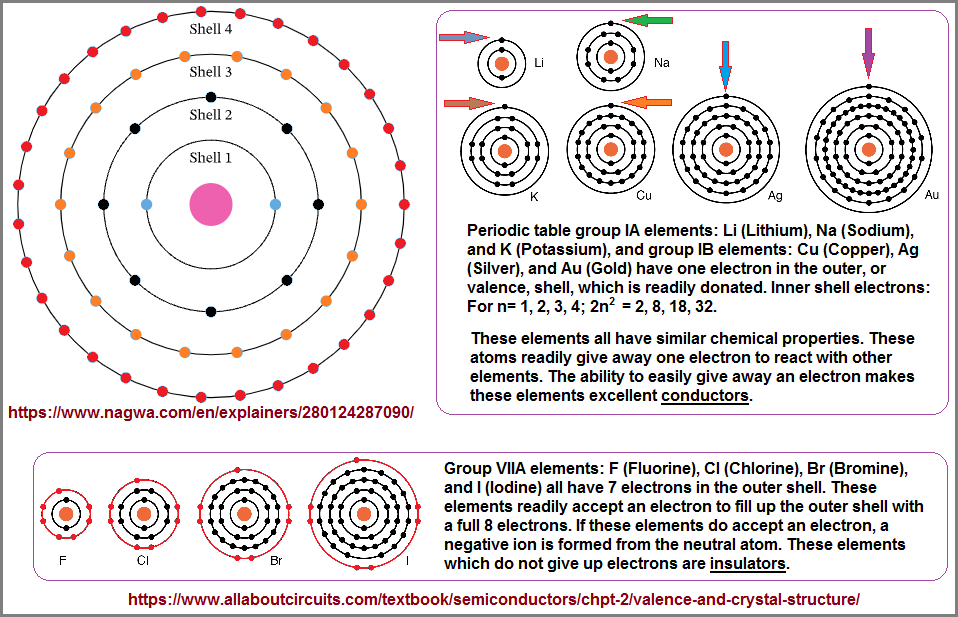
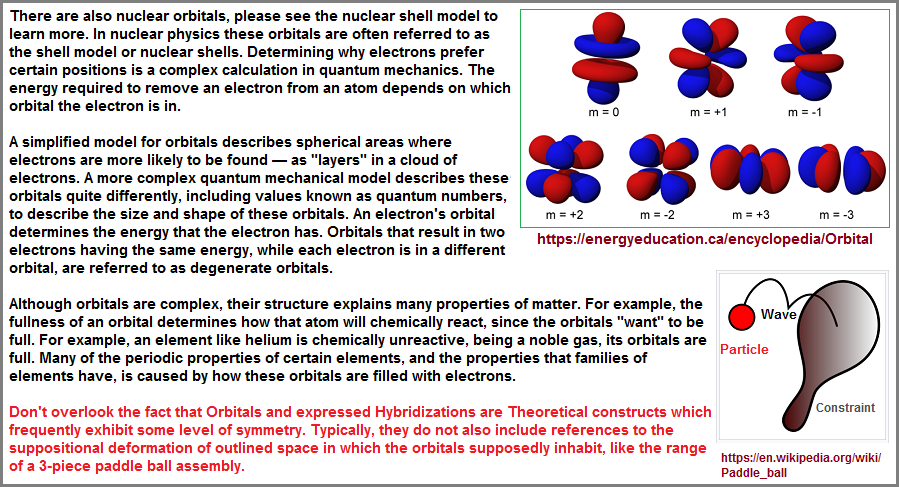
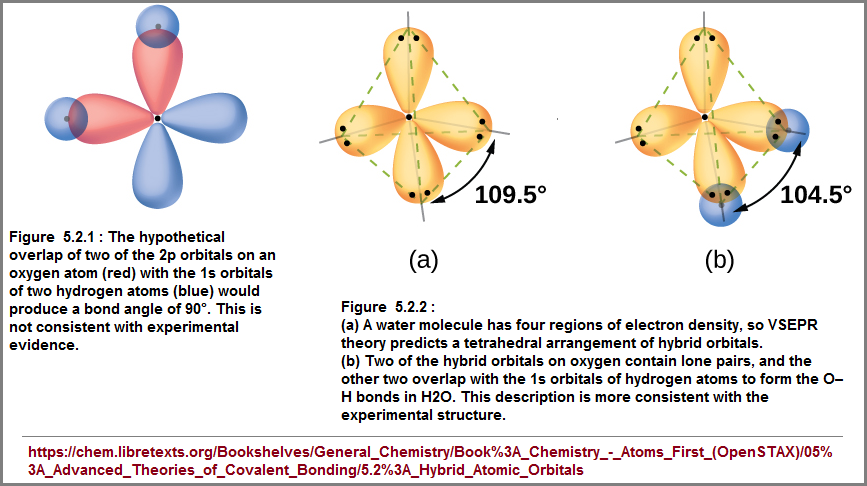
Now that the reader either has a refresher or introduction to electron energy shells theory, the introduction of a different model using the analogy of a tall building with an elevator stopping at different floors which have different quantities of rooms, may be of value... or humor, depending on one's disposition.
Instead of thinking of the atom as an onion with multiple layers, let us view it as a building... such as a hotel with seven floors:
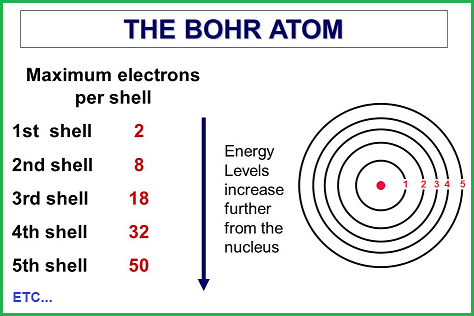
- The lobby of the hotel is where the administration of the hotel congregates. This is equivalent to the position of neutrons and protons.
- The elevator is an electron which can be counted as a room if it stops on a floor too long with an open doorway.
- The different floors from the ground up (the ground energy state), have different quantities of rooms. For example, in the case of the magic numbers
involving atomic nuclei, we have the configuration of:
- The first floor (shell layer or orbital) above ground level has two rooms.
- The second floor has eight rooms.
- The third floor has eighteen rooms.
- The fourth floor has 32 rooms.
- The fifth floor has 50 rooms..
- The elevator can act as an electron which becomes another room on a floor... and can stay or leave at different intervals.
- If we say the elevator can descend below the ground floor, we head into a territory where the ground state energy is altered into an "anti-state".
- If by some quirk that the elevator gets stuck between floors, even though the shell model says this is impossible for an electron to do, we provide ourselves with an allowance for thinking outside the conventional box of theories.
- If the elevator can descend further, we enter into the areas of "darkness": dark matter (where things are not distinct) and dark energy (where apprehension and fear mount)... and in science fiction movies there often is some unknown monster awaiting a group of explorers or investigators.
- While the model in a conventional-Hotel-building sense speaks of vertical movement between energy states and thus dispositions of matter ((solid, liquid, gas as well as matter/anti-matter), it also presents us with the option to think about horizontal and diagonal movements by way of stairways, ramps, and escalators.
As amusing as the above analogy may be to some, we do encounter a problem when speaking of the "magic numbers" of atoms contrasted to nuclei, and need to move from a single building purview to that of a twin tower perspective:
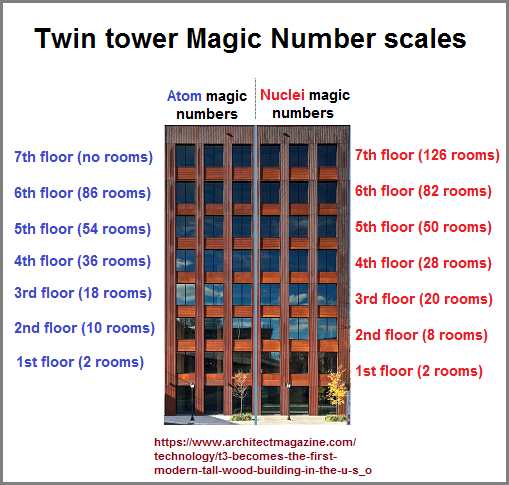
A further interesting point to bring up with respect to the twin towers analogy is the idea of an elevator moving between floors (shells) on the inside between the buildings, thus having a front and back opening which stops on identical levels, or separate internal elevators with a single entrance/exit door, or the usage of external elevators. Then again, we also have to decide if the elevator is a "square-like" box or is cylindrical shaped; the latter conforming more to the idea of a roundish particle, while an escalator appears to be the best representation of a "wavy" wave, unless the waves seen on an oscilloscope do not and can not exhibit linear (without "humps and valleys") particle waves. Since electrons are external to the nucleus of an atom, we might "have to" insert an external type of craft/vehicle and method to ascend and descend the floors. Is there one internal and/or external elevator to service both buildings? If a single internal one, does it have front and back doors? Is/are the elevators cylindrical-shaped or of the box-like shape? Do Electrons move by way of a tube or shaft analogous to a Pneumatic tube system? Is there a screw-like movement from one level to the next?
The idea of a "shared" elevator is interesting and so is the reference of a shiny, reflective, mirror-like surface seen on at least the front doors of some elevators due to the stainless steel polished by house-keeping janitors. All such items bode well as analogical metaphors for atomic particle ideas interacting with one another, as well as the feelings some elevator riders experience as if on an amusement ride at a carnival or fair... depending on whether one is expressing an opinion about jerkiness or acceleration and apprehensiveness... as well as the relief some people show once they've reached the floor for their ensuing destination. One would not necessarily want to get stuck in the elevator with such individuals who might well panic. Which brings to mind whether particles "feel" experiences in their respective domains. Not necessarily in terms of biologically-based sensations, but those respective of matter states of existence.
Let us look at elevator designs. It is of need to keep in mind occupancy load, speed and height of ascent/descent, even though the following does not give all such details: (A guide for choosing the type of elevator you need.) It is also helpful in our musing to think about types of conservation (energy, distance, speed, etc...), since there are limits in which elevators (and escalators) are built and run.
- Geared and Gearless Traction Elevators, separated into three types:
- Traction Elevator- This elevator has ropes that pass over a wheel attached to an electric motor located above the shaft. The main function of the ropes is to raise and lower the elevator car. It can be used for both mid and high-rise applications and can travel much faster than hydraulic elevators. Like other elevator types, this system uses a counterweight, which eliminates the weight of the occupants and the car so that the motor has an easier job moving the elevator load.
- Geared Traction Elevator- The geared elevator is made up of a motor that has a gearbox attached to it. The main function of the gears is to power the wheel that moves the ropes. This type of elevator can travel up to speeds of up to 500 feet per minute. The maximum distance it can travel is 250 feet.
- Gearless Traction Elevator- Gearless elevators don’t have a gear for speed regulation. This explains why they can move as fast as 2,000 feet per minute and can also travel a maximum of 2,000 feet. They are the best option for skyscrapers.
- Hydraulic Elevator- Hydraulic elevators are normally given support by a bottom-placed piston. The purpose is to push the elevator car up while an electric
motor forces hydraulic fluid down the piston. When it’s time for the elevator to come down, the valve releases the hydraulic fluid from the piston. This type of
elevator is mostly used in 2 to 8 story buildings and can only travel at a maximum speed of 200 ft per minute. Below is a further breakdown of three types of
hydraulic elevators:
- Roped Hydraulic Elevator- This type applies the use of both ropes and a piston to enhance the motion of the elevator car. The maximum distance it can travel is about 60 feet.
- Conventional Hydraulic Elevator- Designed with an elevator pit, it comes with a sheave that extends beneath the floor of the pit. As the elevator begins to drop, the pit supports a retracting piston. In some configurations, a conventional hydraulic elevator may require a shallower hole below the pit that accepts a collapsing telescoping piston when the elevator drops. The approximate distance it can travel is 60 feet.
- Hole-less Hydraulic Elevator- The Hole-less Hydraulic Elevator is similar to the conventional one, but it doesn’t require a hole or sheave fixed below the pit. It has telescoping pistons at the base of the pit. These pistons allow the elevator car to travel up to 50 feet. There is also a design that has non-telescoping pistons, which can only allow up to 20 feet of travel.
- Machine-Room-Less (MRL) Elevator- Most elevators are designed with a machine room located above the elevator shaft. This type of elevator has a machine fitted in the override space, and it can only be accessed through the top of the elevator car whenever maintenance is required. This type of elevator can only travel a distance of 250 feet with speeds of up to 500 feet per minute. MRL elevators are gaining popularity with mid-rise buildings because they conserve energy and require less room during construction.
- Vacuum (Air Driven) Home Elevator- Introduced to the elevator community in 2005, vacuum elevators do not use any cables or pulley system to operate. These
Air-Driven elevators operate based on the natural laws of physics. Constructed with polycarbonate and aluminum materials, this lift system is basically a tube
in a sealed vacuum. The air beneath and above the elevator car is what facilitates movement. When you push the up button, the system lowers pressure above the
tube, forcing the air pressure below to push the tube upwards. The opposite happens as you go down – pressure below is minimized, forcing the elevator to go
down.
Because this type of elevator is available in 3 models, ranging from a single passenger to a three passenger wheelchair accessible model, they are mostly used in residential applications.
While it is not conventional to think of particles moving between energy states by way of an elevator, it is an amusing contemplation. Equally so, the idea of an electron moving around making it difficult to locate its actual presence reminds me of trying to locate someone in a house of mirrors. If you think you have found the real person and only end up with a reflection, one must wonder if the presumed electron "cloud" is not actually a reflection of human perception playing tricks on the human brain instead of the other way around.
Many such expressions exist which reflect some underlying geometric model, even if a person does not consciously create a visually attendant geometric mapping; the whole of which we take for granted and call "normal", just as we do the creation of some hybrid idea, though the exact idea may have an application and functionality which produces an innovative circumstance which attendant with some form of economic profile. We take our "moving" thought processes for granted and assign different values to this and that thought (and/or feeling) which either describes or subscribes to a relative motion of thought that has a different rotational orientation (Velocity: direction and position), or speed (rate at which a velocity is occurring) which inhibits correlating such occurrences with being that which was influenced by some environmental activity such as the revolution of a circular-like planet along a linear-like trajectory which also is in a relative circular motion like an elongated spring. If everyone in a crowd are rotating around a given idea and then someone comes along and describes an idea that is faster or slower or similar, and also provides a different direction and position, then a "revolution" in thought or its variant spelled as "evolution" may take place with multiple people gravitating towards the new idea. What we are seeing in planetary activities taking place on the human level, though the may play out in the life cycle of all life forms, as well as atomic, molecular and cellular activities such is described by a life "cycle", citric acid "cycle", and even handedness, if handedness is a repetition occurring cyclically.
If we did not know the Earth was revolving and instead ascribed all movement to external objects in the skies and heavens, then upon being shown a picture or a painting, (etc.), it would be interpreted as a non-moving object just like the images prominently exhibited concerning the yin/yang circular symbol.
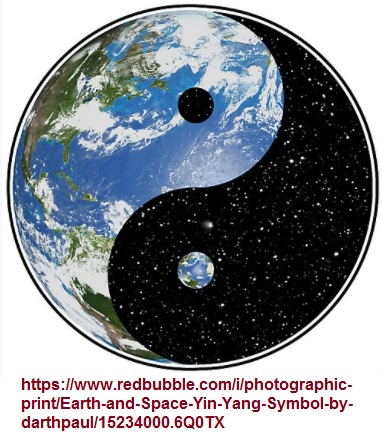
A symbol supposedly representing dualities such as hot/cold, dark/light, night and day, etc., surely must move with the changes since if we keep it one way, it will be overlapped by the opposite during an Earth's rotation. Whereas we don't customarily view the Yin/Yang symbol as a type of compass pointing true to each of its orientations such as night and day, we can think of it as such and thus also consider that it is supported by some means which permits it to turn. Then again, the simple symbol is incorrectly illustrated if we attach to it the multiple movement of the earth and its place in the solar system, milky way, and larger universe. It should ideally illustrate all such relative movements just as life forms on Earth may well do, but no one has taken a look for them because the idea never came to mind. The yin/yang symbol needs to spin accordingly, or else how thoughts are impressed upon to do so, changing back and forth more like a pendulum than a revolving disk. Metaphysical or not, such movements to a stationary figure would be an interesting addition towards thinking about the symbol as being dynamic and not the static model typically displayed. If it is not moving and not intended to display movement, then let us solidify it further by altering its geometric form into a square for example. Or we could view it as a tree:
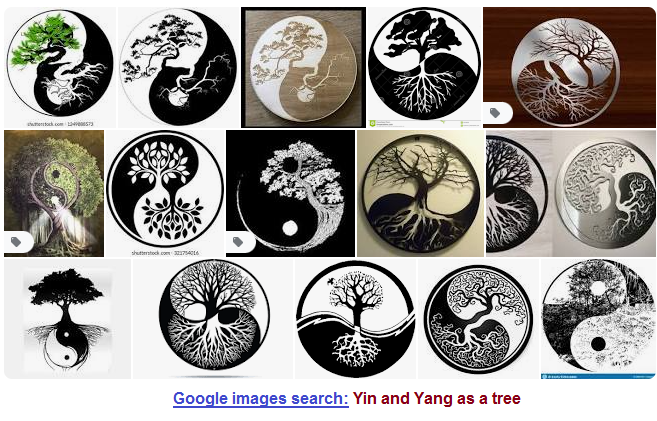
We don't actually think in terms of collisions for the multiple movements of Earth in the Universe as displayed above. Whereas we do think about items such as the solar wind, meteorites and comets, the idea of three related collisions is not a common perspective (That is, by viewing the Earth as a vehicle which we humans occupy... just as life forms are sometimes viewed as a vehicle for DNA). Nor is it common to think of the rather silly way we human display the yin/yang symbol but think of it as a dynamic force and representative vehicle transporting a multitude of dichotomies which is routinely illustrated in a static way. No less, if it is a vehicle, does it crash from time to time or is destined to crash, and we may or may not be able to predict where, when and how? Similar to the collision idea mentioned previously, will there be three types of collisions for the yin/yang symbol and identify in a general sense as an Apocalyptic event? Hence, let us also ask if all Apocalyptic events occur in a series of three collisions?
Let us take an example of an intellectual exercise involving commerce called the Stock Market. Since three types of "collision" have been identified as that which produced a wide-spread economic injury, is this "threeness" a recurring theme, or merely a review of how certain minds perceive events. Indeed, do we actually see a given pattern or only think we do because of some unseen influence such as habit, tradition, or otherwise? This being the case, are we actually on the Third planet or just think we are because of some recurring momentum to follow-through with a culturally practiced mental theme of threeness?
Three reasons for the Stock Market crash of 1929: (What Caused the 1929 Stock Market Crash?
- The proliferation of debt.
- A struggling agricultural sector.
- An excess of large bank loans that could not be liquidated.
On the one hand we may think of polarities and trichotomous possibilities in the polarities, we do not customarily add in the mix (hybridate) the notion of reversals to our thoughts of cyclicities. Whereas we are obsessed with thinking in terms of a beginning to end scenario or longitudinal direction labeled start to finish such as the Earth, Sun, Moon, etc., having been born and will eventually die out, we frequently fail to include the notion of periodic reversals though we know of them such as a person reverting to childhood in old age, a mid-life crisis where a person tries to regain some imagined representation and activity of youth like displaying clothing, hair style, vehicle, mate which exhibits youthfulness... as is the case when someone marries or dates a younger person and the young person an old person... both of which are reversals many might well describe instead as a polarity.
We see many reversals but are not accustomed to describing them in this way. We call them trends, as repetitions, as "the same old thing", or reruns, but not as reversals. Humans are obsessed with the idea of progress. Using the term "reversal" is unacceptable. It hurts our pride. It damages our ego, our self-esteem. We use selfies to give ourselves the impression of change, of progress, of having done something that is different... and this means progress, not repetition, and especially not a reversal. We are not slumming. We are not degenerating. While it is true we age and downgrade our lifestyle, but it is acceptable and even expected in many cases... but this does not mean... or so we might claim, that we are reversing ourselves. Whereas we experience periodic reversals, we engage in behavior, in vocabulary, in interests which provide an illusion byway of embellishment that we are winners... we are progressive or at least are maintaining a level of progress in one aspect or another in our lives... which allows us to find comfort in the recognition... the awareness of some downward trend, perhaps even an opposite approach to a former activity which we were no longer showing progress to ourselves or others in.
It is not common for us to accept the notion that all of us experience periodic reversals... retreats, though we allow ourselves to call an outing as a retreat, not realizing it as a reversal... an allowed reversal to "get back to nature", to get back to our roots. While some readily acknowledge that they have experienced periodic reversals in relationships, employment, vehicle ownership, etc., we may try to conceal such an awareness by over-compensations in some other aspect of our lives by attaching ourselves to an interest in a winning team, or the life of a person who exhibits some type of progress that we identify with and vicariously embrace as an extension of ourselves, though we in fact may be experiencing a long duration of a reversal... a set back, a static "same shit, different day" routine and attitude. We change routines thinking this gets us out of a rut, out of that which can be called a periodic reversal. We vicariously participate in some sport to give ourselves some illusory impression that we are making progress... or at least enjoy that being achieved by another and thus gain a win by supporting them as well... in their career, in their relationship, in their fledgling efforts to achieve that which we identify as being useful, important, or abundant.
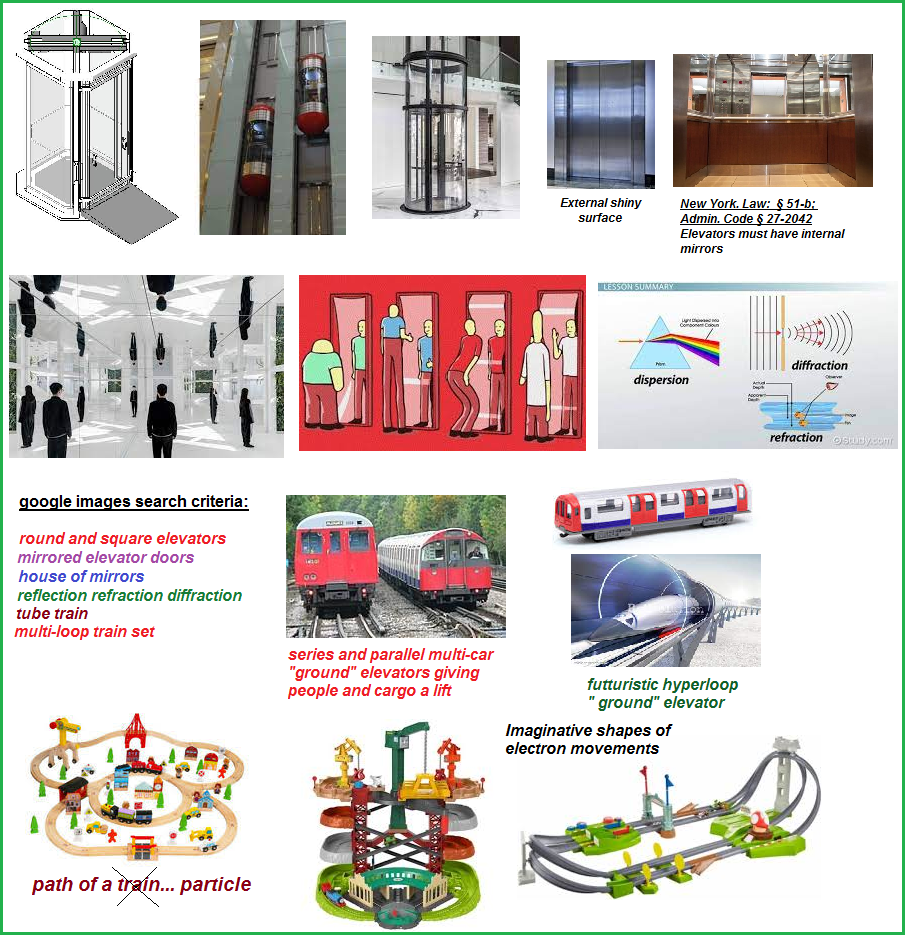
Date of Origination: Friday, 30th July, 2021... 6:38 AM
Date of Initial Posting: Sunday, 10th October, 2021... 4:40 AM